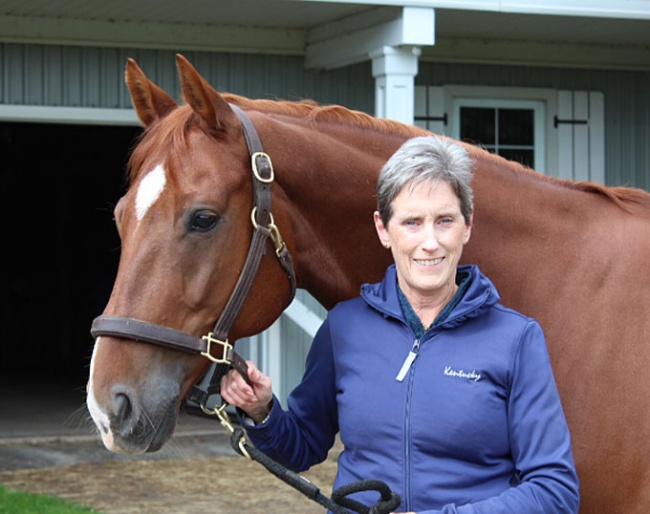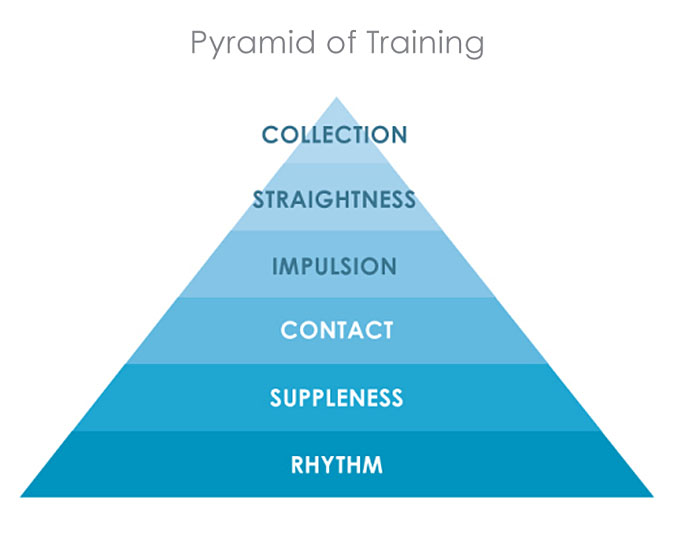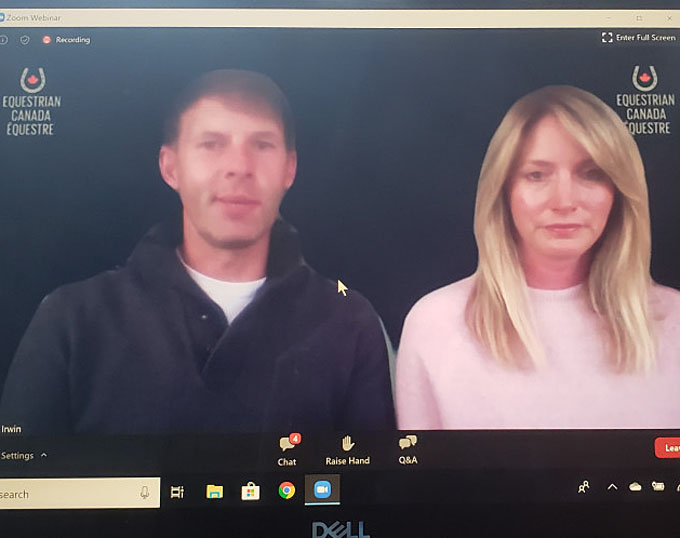
Anne Leueen on Equestrian Canada's webinar on the Training Scale with Canadian Grand Prix riders Tina and Jaimey Irwin
On Friday 8 May 8 at 7 pm Equestrian Canada organized and hosted a webinar with Jaimey and Tina Irwin walking us up the levels of the training scale. Jaimey and Tina are both Grand Prix level riders and I have interviewed both of them on Horse Addict before.
So what is the Training Scale? It is a pyramid and it is pretty much the blueprint for training dressage from the beginning all the way up to the Grand Prix. It looks like this.
So for the webinar I had Jaimey and Tina right at my kitchen table. Please forgive the photo quality I just snapped the screen with my phone.
Starting at the bottom of the scale they both shared their interpretations of the levels and how to achieve them.
RHYTHM Tina told us that this is the foundation upon which a good dressage horse can be built. A clear rhythm is necessary for each of the three gaits: walk four beats, trot two beats and canter three beats. These beats must always be regular and the horse must move forward in the gaits with a good quality energy. Jaimey said it is important to always assess the quality of the gaits and as you train the horse the quality of the gaits should improve. But this takes time. As you work up through the levels you must always be aware of the rhythm and the gaits.
SUPPLENESS Suppleness is achieved through relaxation. The horse cannot be supple unless relaxed and cannot be relaxed unless supple.This is not only physical but also mental. If there is tension in the horse the energy will be blocked. Suppleness will also help with rhythm. These two levels blend in together . All of the levels have an element of blending in together.

“The seat is the motherboard for the computer.” Jaimey said . I highlighted that with my yellow marker!
IMPULSION This is what gives power to the gaits. With impulsion there is more expression in the trot, more jump in the canter. Impulsion is what makes dressage exciting. But Jaimey cautioned us not ask for too much too early in the training; always remain aware of levels 1, 2 and 3 before asking for impulsion. To develop impulsion do transitions between the gaits and within the gaits.
STRAIGHTNESS All horses are crooked. They are born crooked just like we are. How do we make a horse straight? Ride evenly into both reins and evenly between both legs. Jaimey and Tina both emphasized it was very important to have the horse straight in order to maintain good health and soundness. We as riders must also be straight. We need body work; chiropractic, or massage, and exercise to keep us straight. The horse will also need body work. If the horse is very one sided it may be an indication the horse is in pain. We must listen to that. Horses do not always show us pain. In the wild they could not show pain or they would alert a predator to the fact that they were an easier prey. So make sure the horse is in the best working condition and get a vet to check if you suspect a problem.
COLLECTION Jaimey describes collection as: “the icing on the cake, the cherry on the top.” Collection enables the horse to carry more weight behind and to come up in front and take a nice light contact. The horse is now in self carriage. When this is achieved the movements can be “brilliant”. As Jaimey says “That is the ideal and the horse can be like a dancer”.
Once the levels have been mastered the rider still has to be aware of all the levels. Tina suggested using levels 1 , 2 and 3 in the warm up. They will give the foundation for the working part of the ride. Levels 4, 5 and 6 can be the working phase.

Then there were questions from those attending the webinar.
- How do you bring a horse back to work after the Covid 19 time off? Jaimey and Tina both recommended lunging the horse before you got on. “Nobody needs to be a hero here.” Tina said. Also with lunging you will be able to see how the horse is in his body. Is he moving well? Is he sound? What is his energy level? Both Jaimey and Tina reminded us that after a long time off the horse might have great energy to start but would not have endurance fitness and neither would the rider.
- What exercises would help to soften and relax the horse? Lots of transitions, adhere to the training scale, do lots of serpentines and plenty of half halts.
- Do you need to do the scales in order. Would collection not help if you did it first? Both Jaimey and Tina did not agree with this idea. They reiterated that collection is the “end product” To do it first does not make sense and then there could be holes in the horse’s training. “It is not the right thing to do.”
- How many days a week should the horse be ridden to prepare for Fourth Level. Jaimey said this would depend on whether the horse was an older horse and there was no plan to move him to a higher level after fourth level. Or is it a young horse that needs to be developing strength? Tina said for fourth level the horse should be ridden at least four days a week. But hacking out was a good idea to keep the horse fresh mentally and happy.
- How should a rider activate their core when riding? Tina said this comes back to the seat and balance. Good posture is essential and the rider must stay on the vertical and practice good posture at all times both on and off the horse. Once again…..riding with no stirrups was recommended.
- Was there anything in the dressage tests, particularly the lower level tests that Jaimey or Tina would like to see changed? Jaimey and Tina looked at each other and then said that there was not really anything as they both felt the tests were “pretty good”. Jaimey mentioned that in the young horse, 4 year old test, the horse is not required to halt at the start and he felt this was good as it allowed the horse to come in and move on with the test. He thought this could be a good idea for Training level as well.
- What do you do about a horse that gets tense and jigs in the walk? Practice relaxing the horse. For a hot horse that can get excited it is important to keep your legs on the horse. If you take them off the horse starts to worry about what’s happening. Keeping the legs on is comforting.
With that we had run out of time. What did I take away from this webinar”
Riding with no stirrups is a Very Good Idea for a lot of reasons. but most importantly for developing an independent seat. When I get back to riding after the CV19 time off I will have to gradually work myself back into riding fitness. I am doing exercise regularly but only riding uses riding muscles. Once I am back to full riding fitness I am going to ride with no stirrups at least once a week.
by Anne Leueen
Related Links
HorseAddict: Five Habits for Good Horsemanship
HorseAddict: Facing a New Reality of No Riding in Corona Times